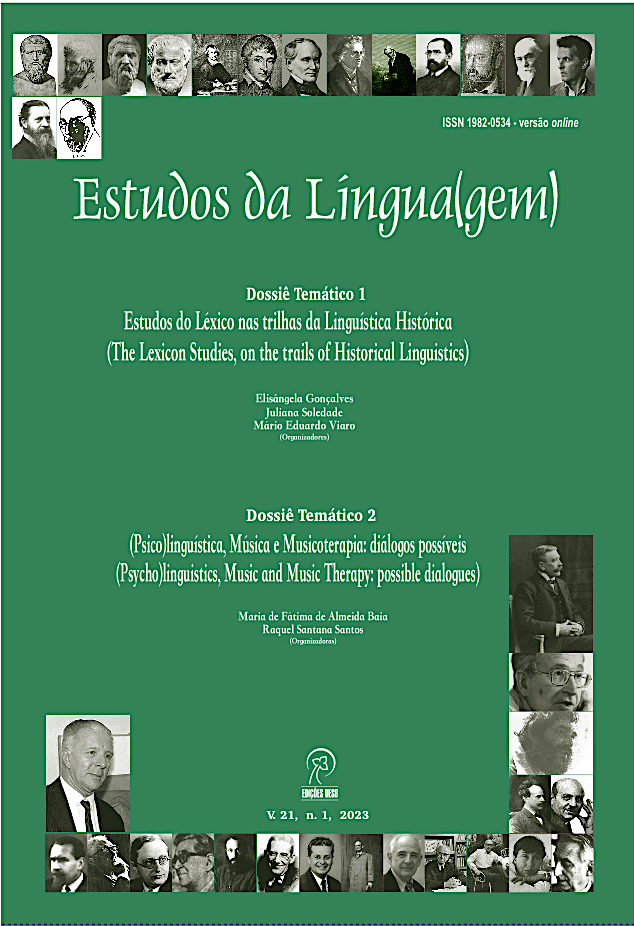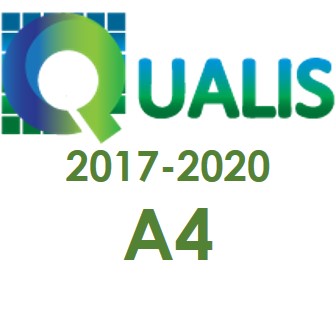Acoustic study of five voice qualities with a sustained note
DOI:
https://doi.org/10.22481/el.v21i1.13382Keywords:
Voice Quality; Singing; Spectral parameter.Abstract
Harmonics-to-noise ratio (0-500, 0-1500, 0-2500, 0-3500, F1, F2, B1, B2. The statistical results have shown that the parameters decrease in the following manner: 1) H1: M > Br > T > Cr > W; 2) H1H2: W > Br > (M = Cr) > T; 3) H1A3: (W=Br) > M > Cr > T; 4) B1: T > W > Br > M > W; 5) B2: M > T > Cr > Br > W; 6) CPP: T > M > Br > Cr > W; 7) Energy: T > M > Cr > Br > W. Moreover HNR presented the same decreasing pattern for the four conditions (W > M > T > Br > Cr), and the formants F1 and F2 also presented a similar decreasing pattern (T > M > Br > Cr > W).
Downloads
References
BALL, M. J.; J., ESLING, J; DICKSON, C. The voqs system for the transcription of voice quality. Journal of the IPA, v. 25, issue 2, p. 71-80, 1995. doi:10.1017/S0025100300005181, 1995.
BOERSMA, P.; WEENINK, D. Praat: Doing phonetics by computer (version 4.5.06). http://www.praat.org/ (Last viewedDecember 8, 2010), 2006.
CATFORD, J. C. Fundamental Problems in Phonetics. Edinburgh University Press, Edinburgh, 1977.
CHOI, H-S.; BERKE, G. S.; YE, M.; KREIMAN, J. Function of the posterior cricoarytenoid muscle in phonation: In vivo laryngeal model, Otolaryngol Head Neck Surg, v. 109, p. 1043-51, 1993.
CHOI, H-S.; BERKE, G. S.; YE, M, Functions of the Interarytenoid (IA) muscle in phonation: in vivo laryngeal model, Yonsei Medical Journal, vol. 36, n.1, 1995.
DALLASTON, K.: DOCHERTY, G. The quantitative prevalence of creaky voice (vocal fry) in varieties of English: A systematic review of the literature. PLoS ONE, v. 15, n. 3, e0229960, 2020.
DICANIO, C. T. The phonetics of register in takhian thong chong. Journal of the IPA, v. 39, n. 2, p. 162-188, 2009.
EDMONDSON, J. A.; ESLING, J. H. The valves of the throat and their functioning in tone, vocal register, and stress: Laryngoscopic case studies. Phonology 520, v. 23, n. 2, p. 157-191, 2006.
GORDON, M. LADEFOGED, P. Phonation types: a crosslinguistic overview, J. of Phonetics, v. 29, p. 383-406, 2001.
ESLING, J. H. There are no back vowels: The laryngeal articulator model. Canadian Journal of Linguistics, v. 50, p. 13-44, 2005.
ESLING, J. H.; MOISIK, S. R.; BENNER, A.; CREVIER-BUCHMAN, L. Voice Quality: The Laryngeal Articulator Model. Cambridge University Press, Cambridge, 2019.
HERBST, C. T. Evaluation of Various Methods to Calculate the EGG Contact Quotient. KTH Speech Music and Hearing, Sweden, Stockholm, Phd Thesis, 2004.
HERBST, C. T. Investigation of four distinct glottal configurations in classical singing—A pilot study. The Journal of the Acoustical Society of America, v.125, EL104, 2009.
HERBST, C. T, HOWARD, D.; SCHLÖMICHER-THIER, J. Using Electroglottographic Real-Time Feedback to Control Posterior Glottal Adduction during Phonation. Journal of Voice, Vol. 24, Issue 1, January 2010, p. 72-85, 2010.
HOLLIEN, H. On vocal registers. Journal of Phonetics, v. 2, p. 125-143, 1974.
KEATING, P.; ESPOSITO, C. M.; GARELLEK, M.; KHAN, S. U. D.; KUANG, J. Phonation Contrast across languages, UCLA Working Papers in Phonetics, no. 108, p. 188-202, 2010.
KLATT, D.; KLATT, L. Analysis, synthesis, and perception of voice quality variations among female and male talkers, J. Acoustic. Soc. Amer., Vol. 87, p. 820-857, 1990.
HILLENBRAND, J.; CLEVELAND, R. A; ERICKSON, R. L. Acoustic correlates of breathy vocal quality, J. Speech and Hearing Research, v. 37, p. 769–778, 1994.
LAVER, J. The phonetic description of voice quality. Cambridge University Press, Cambridge, 1980.
LAVER, J.; MACKENZIE-BECK, E J. Vocal prole analysis scheme: A user's manual. Speech Science Research Centre, Queen Margaret University College-585 QMUC, 2007.
MEIRELES, A.; MIXDORFF, H.. Voice quality in low and high registers in two different styles of singing, in: Proc. Speech Prosody 2020, Tokyo, Japan. p. 5 pages, 2020.
SHUE, Y.-L. The Voice Source in Speech Production: Data, Analysis and Models, PhD Thesis, UCLA, 2010.
SHUE, Y.-L; KEATING, P.; VICENIK, C.; YU, K. Voicesauce: A program for voice analysis, Proceedings of the ICPhS XVII, 2011. P. 1846-1849.
STROSS, B. Falsetto voice and observational logic: Motivated meanings. Language in Society, v. 42, p. 139-162, 2013.
VENNARD, W.; HIRANO, M. Physiological Basis for Vocal Registers. The Journal of the Acoustical Society of America, v. 47, 120, 1970.
YUMOTO, E.; GOULD, W.; BAER, T, Harmonics-to-noise ratio as an index of the degree of hoarseness, J. Acoust. Soc. Am. V.71, p. 1544– 1550, 1982.
Downloads
Published
How to Cite
Issue
Section
License

This work is licensed under a Creative Commons Attribution 4.0 International License.

Estudos da Língua(gem) is licensed under a Creative Commons Attribution 4.0 International License.
Authors who publish in the journal Estudos da Língua (gem) agree with the following terms:
The journal Estudos de Língua(gem) maintains the copyrights of the contributions published. These rights include the publication of the contribution and make its content available for free through the portal.







